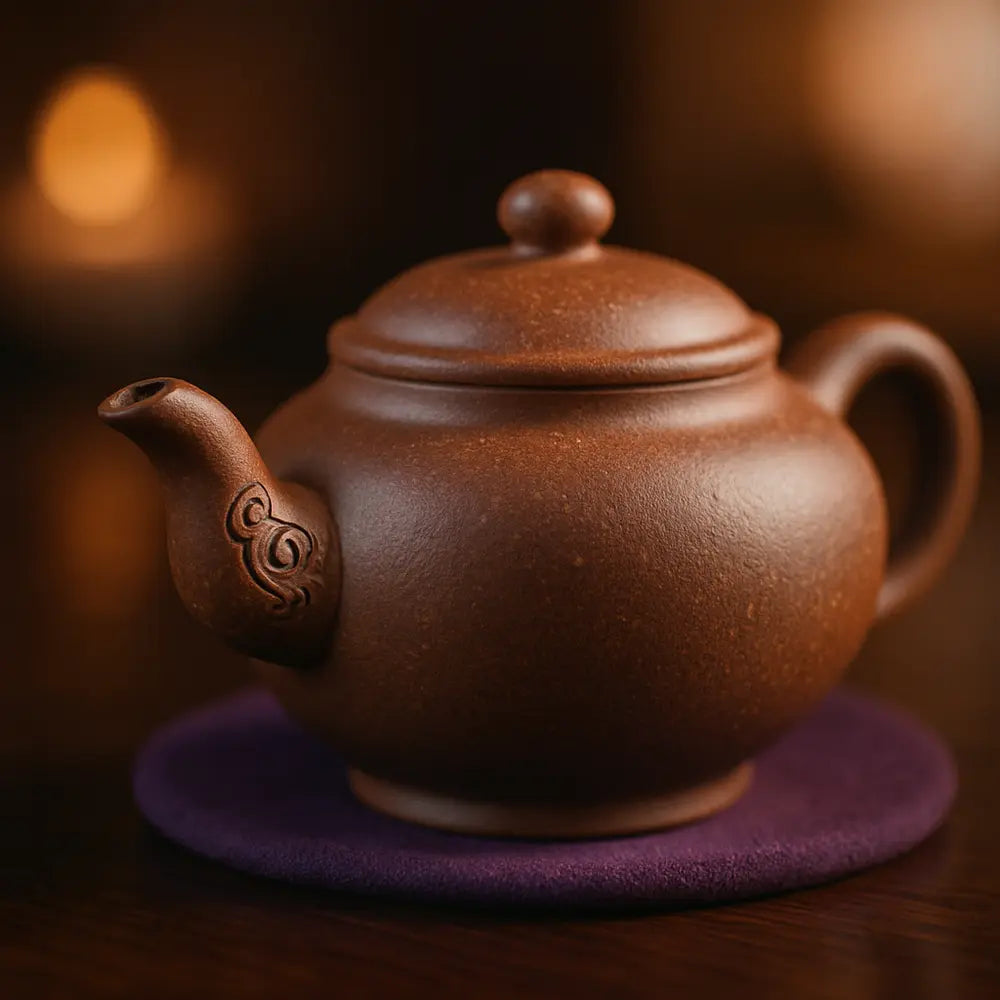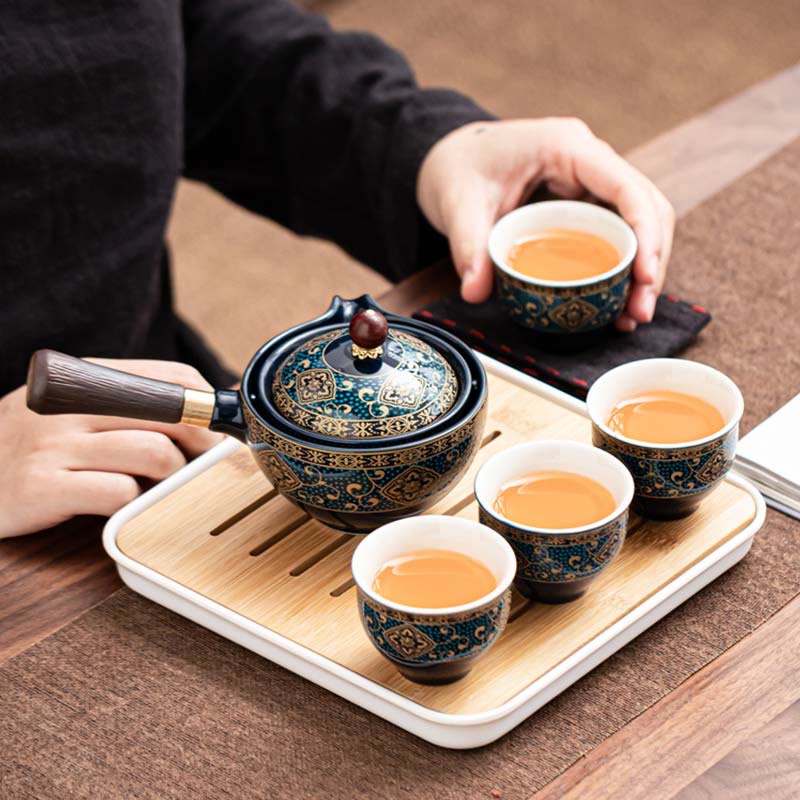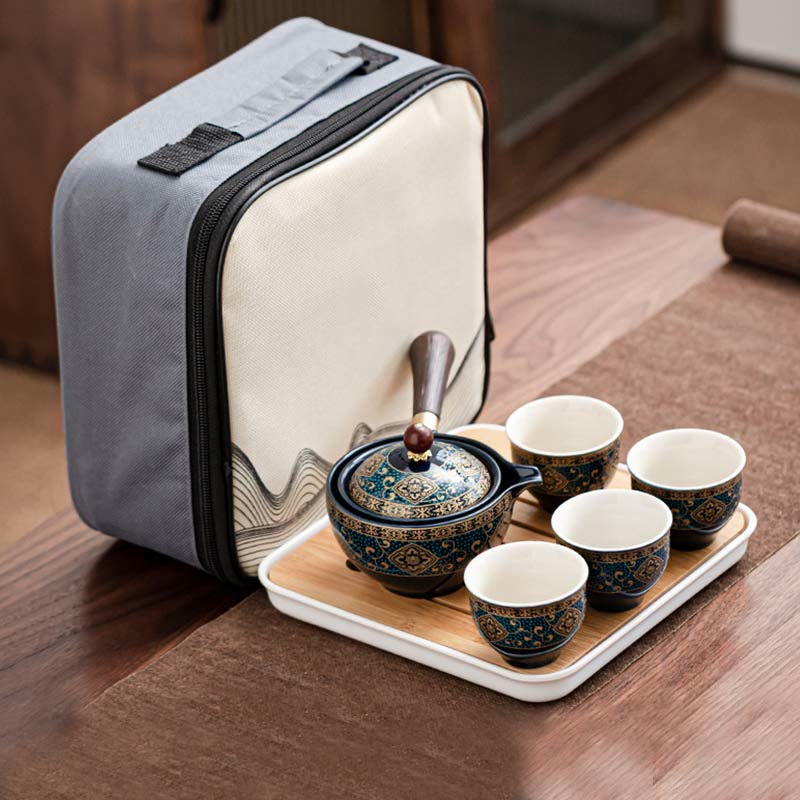
Chinese Teapots
1 product
Showing 1 - 1 of 1 product


Welcome to Healing Sounds, where the ancient art of tea meets soulful craftsmanship. Our curated selection of Chinese teapots invites you to experience the profound ritual of tea brewing, transforming a simple daily practice into a moment of serene connection and mindful presence. Each piece in this collection is more than a vessel; it's a gateway to tranquility and a testament to centuries of tradition.
Discover the heart of Gongfu Cha with a teapot that resonates with your spirit. Whether you seek the storied elegance of a Yixing teapot or the classic charm of porcelain, our collection offers authentic pieces designed to elevate your tea journey.
The Enduring Legacy of the Chinese Teapot
The chinese teapot is not merely a utilitarian object; it is a cornerstone of Chinese culture and a symbol of hospitality, refinement, and contemplation. For centuries, these teapots have been central to the art of tea, evolving in form and material yet always retaining their essential purpose: to brew the perfect cup of tea. The rich history embedded in each design speaks to a legacy of artistry passed down through generations.
At Healing Sounds, we understand that a teapot's journey is as important as its destination. We celebrate the lineage of these exquisite items, from the humble workshops of ancient artisans to the modern tea connoisseur's table. This collection honors the timeless appeal and profound cultural significance of the chinese teapot.
Exploring the World of Chinese Teapot Materials
The character and performance of a chinese teapot are deeply influenced by the material from which it is crafted. Each substance offers unique properties that affect heat retention, flavor development, and aesthetic appeal, making the choice of material a crucial aspect of selecting your ideal teapot.
From the revered purple clay of Yixing to the delicate translucence of porcelain and the robust nature of other ceramics, understanding these materials is key to appreciating the nuances of Chinese tea culture. We delve into the most significant types, helping you find a teapot that perfectly complements your brewing style and tea preferences.
Yixing Zisha Teapots The Soul of Gongfu Tea
Among the most prized materials for a chinese teapot is Zisha clay, sourced from the region of Yixing in Jiangsu province. These are famously known as Yixing teapots or zisha teapots. This unique purple clay is renowned for its porosity, which allows the teapot to absorb the tea's essence over time, enhancing the flavor of future brews.
The unglazed nature of Yixing teapots means they "season" with use, developing a rich patina and a unique character that reflects the teas brewed within. This makes each clay chinese teapot a personal journey, evolving with its owner. The specific mineral composition of Zisha clay also contributes to its excellent heat retention properties, crucial for brewing teas like oolong and pu-erh.
Many tea enthusiasts believe that the best Yixing teapot is one that has been used for many years, dedicated to a single type of tea. This dedication prevents the mingling of flavors and allows the teapot to fully express the character of that specific tea.
Porcelain Teapots Elegance and Purity
Porcelain teapots offer a different, yet equally cherished, tea brewing experience. Known for their delicate beauty and non-porous nature, porcelain teapots do not absorb flavors or aromas, making them ideal for brewing a variety of teas, especially fragrant ones like green, white, or floral teas. The true taste of the tea is preserved with each infusion.
The classic chinese blue and white teapot is a timeless example of porcelain artistry, often adorned with intricate hand-painted designs depicting landscapes, flora, or mythological scenes. These teapots are not only functional but also serve as exquisite decorative pieces, adding a touch of elegance to any tea setting. Their smooth, glazed surface is easy to clean and maintains its pristine appearance over time.
Other Ceramic Traditions in Chinese Teapots
Beyond Yixing clay and porcelain, China boasts a rich heritage of other ceramic teapots. Materials like celadon, with its distinctive jade-like glaze, and various stoneware clays offer diverse aesthetic and brewing characteristics. Each region and kiln has developed unique styles and techniques, contributing to the vast tapestry of chinese ceramic teapot traditions.
Some traditions, like those from Chaozhou, specialize in smaller teapots ideal for the concentrated brews of Gongfu style. These teapots, often made from local clays, are highly regarded for their ability to enhance specific tea types. Exploring these varied ceramic traditions reveals the incredible depth and artistry inherent in the world of the chinese teapot.
Authenticity and Quality in Your Chinese Teapot
When selecting a chinese teapot, particularly a prized Yixing teapot or zisha teapot, authenticity of materials and quality of craftsmanship are paramount. A genuine, well-crafted teapot will not only enhance your tea brewing experience but can also become a cherished heirloom.
At Healing Sounds, we are committed to sourcing teapots that honor traditional craftsmanship and utilize authentic materials. We believe in transparency and providing our community with the knowledge to appreciate the subtle markers of quality that distinguish an exceptional clay chinese teapot.
Understanding Yixing Zisha Clay Quality
The quality of Yixing Zisha clay is a critical factor. True Zisha clay possesses a unique mineral composition and porous structure. The clay's texture, firing temperature, and the artisan's skill all contribute to the final teapot's performance. High-quality Yixing clay will feel smooth yet subtly textured, and the teapot should have a clear, resonant sound when tapped lightly.
Authentic Yixing clay teapots are known for their ability to "breathe," which is attributed to their unglazed, porous nature. This characteristic is said to round out the flavors of tea, particularly darker oolongs and pu-erhs. Be wary of teapots with overly bright, artificial colors or unusually low prices, as these can be indicators of non-authentic materials or lower-grade clay.
Identifying Handcrafted Chinese Teapots
Distinguishing a handmade chinese teapot from a mass-produced one involves looking for subtle signs of the artisan's touch. Handcrafted teapots often exhibit slight asymmetries or individual marks that speak to their unique creation process. The fit of the lid, the alignment of the spout and handle, and the overall balance of the teapot are key indicators of skilled craftsmanship.
Inside a handcrafted teapot, you might find faint tool marks or the texture left by the potter's fingers. Mass-produced teapots, often made using molds, tend to have a more uniform and perfectly symmetrical appearance. While both can be functional, a handcrafted piece carries the spirit and dedication of its maker, adding an intangible value to your tea ritual.
Many artisans also use personal seals or chops, impressed into the clay usually on the bottom of the teapot or under the lid, as a signature of their work. Researching these seals can sometimes help in identifying the potter or workshop.
Design and Aesthetics From Traditional to Modern
The design of a chinese teapot is a rich field of artistic expression, ranging from timeless traditional forms to innovative modern interpretations. The shape, size, and decoration of a teapot are not merely aesthetic choices; they often reflect specific cultural periods, regional styles, and even philosophical concepts.
Whether you are drawn to the historical reverence of an antique chinese teapot or the sleek lines of contemporary design, the aesthetic appeal of your teapot plays a significant role in the overall tea experience. It is a visual dialogue that enhances the sensory pleasure of brewing and drinking tea.
Traditional Chinese Teapot Shapes and Symbolism
Traditional chinese teapot shapes are often imbued with deep symbolism and historical significance. Classic forms like the "Xishi" (named after one of the Four Beauties of ancient China, known for its rounded, harmonious form) or the "Shui Ping" (level water pot, designed for balance) have been refined over centuries.
These shapes are not arbitrary; they are often optimized for specific types of tea or brewing methods. The curves and proportions are carefully considered to ensure good balance, comfortable handling, and an even pour. Decorations might include symbolic motifs such as dragons for power, phoenixes for grace, bamboo for resilience, or plum blossoms for perseverance.
Modern Interpretations and Artistic Innovations
While tradition remains a strong influence, contemporary artisans continue to explore new forms and aesthetic expressions in chinese teapot design. Modern teapots may feature minimalist lines, unconventional materials, or abstract decorations, reflecting current artistic trends and individual creativity.
These modern designs often seek to balance functionality with a fresh visual appeal, catering to a new generation of tea lovers who appreciate both heritage and innovation. The fusion of traditional techniques with contemporary sensibilities results in teapots that are both functional works of art and reflections of an evolving tea culture.
At Healing Sounds, our collection seeks to represent this spectrum, offering pieces that honor the rich legacy of chinese teapot design while also embracing the dynamism of modern artistry. We believe a teapot should resonate personally, whether it's a classic piece or a contemporary creation.
Choosing the Perfect Chinese Teapot for Gongfu Tea
Selecting the right chinese teapot, especially for the nuanced practice of Gongfu Cha (or Gong Fu brewing), involves careful consideration of size, capacity, and how these factors align with your tea preferences and brewing habits. The Gongfu method emphasizes multiple short infusions, making teapot characteristics particularly important.
A well-chosen teapot can significantly enhance your control over the brewing process, allowing you to extract the optimal flavor and aroma from your tea leaves. It becomes an extension of your intention, a tool that helps you connect more deeply with the tea.
Size and Capacity Considerations for Gongfu Brewing
Gongfu tea brewing typically utilizes smaller teapots, often ranging from 80ml to 200ml in capacity. This smaller size allows for a higher leaf-to-water ratio, resulting in a concentrated, flavorful infusion. The idea is to appreciate the evolving character of the tea over several steepings.
When choosing a size, consider how many people you usually brew for. For solo sessions or brewing for two, a teapot around 100-150ml is often ideal. Larger groups might require a slightly bigger pot, or you might opt to use multiple small pots. The key is to match the teapot capacity to your typical serving size to ensure each infusion is enjoyed at its peak.
Many chinese teapots are part of a larger gongfu tea set, which includes matching cups, a tea pitcher (cha hai or fairness cup), and other accessories. Considering the teapot as part of this ensemble can also influence your choice.
The Role of the Teapot in the Tea Ceremony
In a traditional tea ceremony, the chinese teapot is more than just a brewing vessel; it is a centerpiece, an object of contemplation, and a facilitator of shared experience. Its aesthetic qualities, the way it feels in the hand, and the grace of its pour all contribute to the meditative and communal atmosphere of the ceremony.
A ceremonial teapot is chosen not only for its brewing capabilities but also for its beauty and the story it tells. It might be a prized antique chinese teapot, a masterfully crafted Yixing teapot, or a beautifully decorated porcelain piece. The act of brewing and serving tea from such a teapot becomes a mindful ritual, fostering connection and appreciation.
Whether you practice formal tea ceremonies or simply enjoy a quiet moment of tea brewing, your chosen chinese teapot can transform the experience, making it a more intentional and enriching part of your day.
The Healing Sounds Promise Authentic Teaware for Your Soulful Journey
At Healing Sounds, our passion for authentic spiritual tools extends deeply into the world of tea. We believe that a genuine chinese teapot can be a profound instrument for mindfulness, healing, and connection. Our collection is curated with intention, seeking out pieces that embody quality, tradition, and artistry.
We strive to provide teapots that are not only beautiful and functional but also ethically sourced and representative of true craftsmanship. Whether you are a seasoned tea master or new to the art of Gongfu brewing, we are here to support your journey with teaware that resonates with the benevolent and inspiring energy of Healing Sounds. Our selection of chinese teapots and cups is chosen to bring harmony and joy to your tea rituals.
Our commitment extends to ensuring you understand the heritage and care of your chosen piece. We believe that appreciating the story behind your collectible chinese teapots enriches the experience of using them, fostering a deeper connection to this ancient tradition.
Embrace the art of tea with a chinese teapot from Healing Sounds. Let each infusion be a reminder of the beauty in simplicity, the depth in tradition, and the healing power found in mindful moments. Our collection is continually enriched, reflecting our ongoing exploration of the finest teaware traditions.
Frequently Asked Questions about Chinese Teapots
A Chinese teapot is generally called a "cháhú" (茶壶) in Mandarin. Specific types might have more distinct names, such as "Zǐshā hú" (紫砂壶) for Yixing clay teapots. The term broadly refers to the vessel used for brewing tea leaves.
Various clays are used, but the most famous is Zisha clay (purple sand clay) from Yixing, Jiangsu province, used for Yixing teapots. Other materials include porcelain, stoneware, and other regional ceramic clays like Chaozhou clay. Each material imparts unique characteristics to the brewed tea.
Authenticity, especially for Yixing Zisha clay teapots, is ensured by sourcing from reputable artisans and regions known for genuine materials. Factors include the clay's origin, mineral composition, texture, and the traditional firing methods used. Certificates from recognized masters or workshops can also indicate authenticity for high-value pieces.
Yixing Zisha clay is unique due to its high iron content and porous structure after firing. This porosity allows the unglazed teapot to "breathe" and absorb tea oils over time, enhancing the flavor, aroma, and texture of subsequently brewed teas. Different types of Zisha clay (like Zini, Hongni, Duanni) also offer varied colors and brewing characteristics.
A Xishi teapot (西施壶 - Xī Shī hú) is a classic and popular chinese teapot shape, particularly favored in Yixing clay. It is named after Xishi, one of the renowned Four Beauties of ancient China. The shape is characterized by its perfectly round, globular body, a short spout, and an ear-shaped handle, symbolizing harmony and elegance. It is often small, ideal for Gongfu brewing.
Handcrafted teapots often show subtle irregularities, tool marks (especially inside), or slight asymmetries that reflect the artisan's touch. The lid fit might be perfectly snug but unique. Mass-produced teapots, typically mold-made, tend to be perfectly uniform and symmetrical, with smooth, identical interiors. Handmade chinese teapots often carry an artisan's seal or signature.
Traditional chinese teapot designs often adhere to classic, historically established shapes (like Xishi, Shui Ping), proportions, and symbolic decorative motifs passed down through generations. Modern designs may experiment with new forms, minimalist aesthetics, abstract decorations, or innovative material combinations, reflecting contemporary artistic trends while often still valuing functionality.
For Gongfu tea (Gong Fu brewing), smaller teapots are preferred, typically ranging from 80ml to 200ml. This allows for a high leaf-to-water ratio and multiple short infusions. A common size for personal use or for two people is around 100-150ml. The choice depends on the number of people being served and personal preference for brew concentration.
The cost of a Yixing teapot varies dramatically, from under a hundred dollars to many thousands, or even more for antique or master-crafted pieces. Factors influencing price include the quality and rarity of the Zisha clay, the skill and reputation of the artisan, the level of craftsmanship (handmade vs. partially handmade), age, and intricacy of design. Genuine, good quality entry-level Yixing teapots often start in the $100-$300 range.
Key differences lie in typical materials, design aesthetics, and usage. Chinese teapots, like Yixing teapots, are often made from unglazed clay and are central to Gongfu brewing. Japanese teapots (kyusu) commonly feature side handles, are often glazed ceramic or porcelain, and are designed for brewing Japanese green teas like sencha. While both prioritize functionality, their forms and associated tea cultures have distinct characteristics.
Explore our curated selections and find the perfect vessel to begin or continue your tea journey. For more inspiration on teaware and ceramics, you can explore our broader chinese-ceramics collection.


